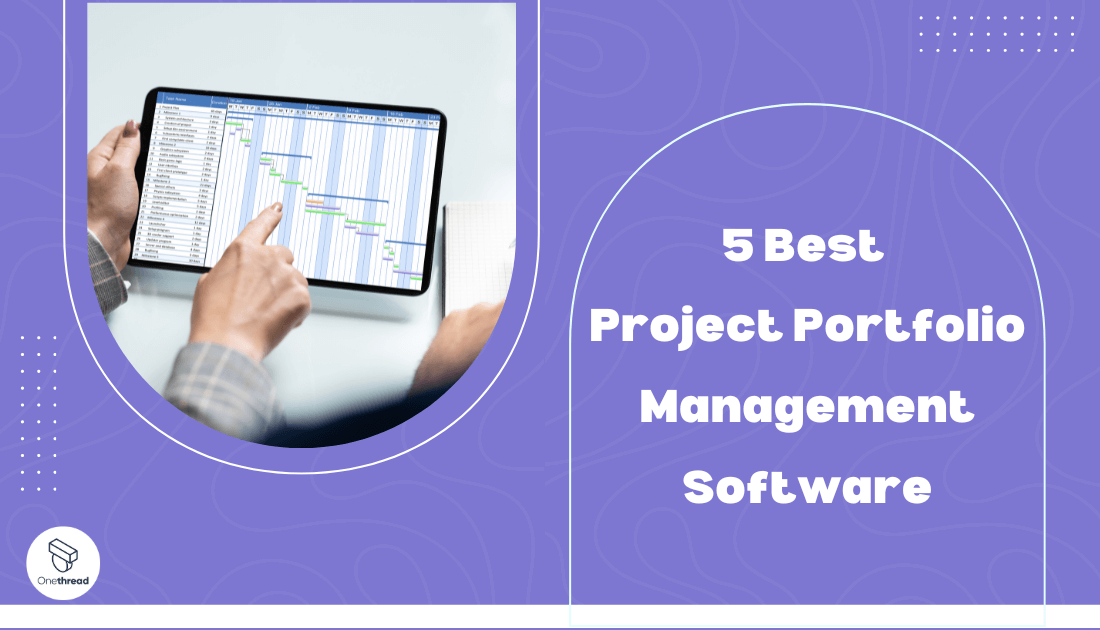Hello, fellow project enthusiasts! In today’s fast-moving business world, we all know that being really good at managing projects is super important. Whether you work in a small company, a big one, or somewhere in between, making sure your projects go smoothly can make a big difference in your success.
That’s where Project Portfolio Management (PPM) software comes in. It’s like having a helper that makes sure your projects match your big plans, helps you use your resources wisely, and keeps everything organized.
But there are lots of PPM tools out there, like different tools in a toolbox. It can be tough to pick the right one. That’s where we come in. We’re here to help you understand the 5 best Project Portfolio Management software options.
Whether you’re a project pro who wants to do even better, a leader with big ideas, or someone who knows their tech stuff, our guide will show you the way. Think of it as your guidebook on a journey to doing projects really well, with your PPM software as your trusty sidekick. Let’s start this adventure!
Quicklists of Best Project Portfolio Management Software
- Onethread: Perfectly balances user-friendliness with robust project management capabilities.
- Microsoft Project: Excel due to seamless integration with Microsoft tools and comprehensive features.
- Smartsheet: Ideal for small to medium-sized teams, offering simplicity, flexibility, and excellent collaboration tools.
- Asana: Focuses on simplicity and real-time collaboration for streamlined project management.
- Planview: Tailored for organizations with complex project portfolios, offering strategic planning, financial tracking, and resource management features.
Our reviewers evaluate software independently. Clicks may earn a commission, which supports testing. Learn how we stay transparent & our review methodology
Comparison Chart Of Best Project Portfolio Management Software
Here is top 5 list of best project portfolio management software (with features highlighted)
Platform | Key Features and Purpose | Collaboration Capabilities | Task and Note Management | Visualization Management |
 | Streamlines project management and task tracking. | Thread-based task management with custom fields | Collaboration through shared project files, task assignments, commenting, notifications. | Kanban boards, calendar view, Gantt chart view, basic analytics, and project progress. |
 | Project planning and management, resource allocation. | Collaboration through shared project files, task assignments, commenting, and notifications. | Manages tasks and resources, project planning. | Gantt charts and timelines for project visualization. |
 | Merges spreadsheets with project planning. | Real-time collaboration, task assignment, commenting, file sharing, notifications, shared workspaces. | Manages tasks, projects, and data with spreadsheet power. | Provides visualization of tasks, projects, and data. |
 | Effective task, project, and work process management. | Real-time collaboration, task assignment, commenting, file sharing, notifications, task dependencies. | Manages tasks, projects, and processes effectively. | Provides visualization of task progress and timelines. |
 | Portfolio and project management with a focus on strategy. | Real-time collaboration, task assignment, commenting, file sharing, notifications, portfolio management. | Manages tasks, projects, and portfolios strategically. | Provides visualization of portfolio performance. |
What is Project Portfolio Management Software?

Project Portfolio Management Software, often referred to as PPM software, is a powerful tool that helps organizations effectively plan, prioritize, execute, and oversee multiple projects simultaneously. It enables businesses to align their project portfolios with strategic goals, allocate resources efficiently, and gain valuable insights through reporting and analytics.
PPM software is essential for optimizing project investments, managing risks, and ensuring that projects contribute to the overall success of the organization by providing a centralized platform for project management and decision-making.
How Project Portfolio Management Software Can Help Your Business
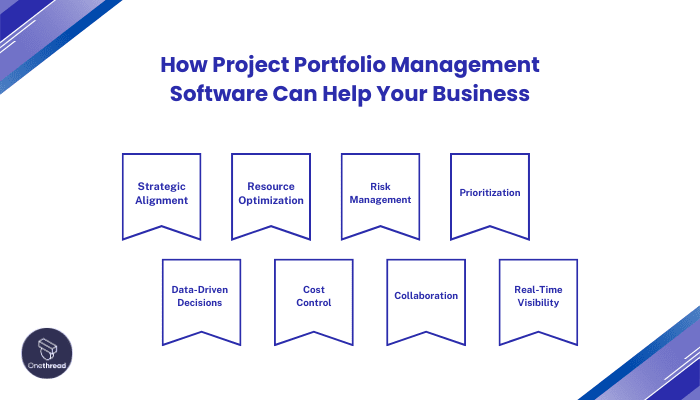
Here are some ways in which Project Portfolio Management (PPM) Software can help your business:
- Strategic Alignment: Align projects with your business strategy for better overall outcomes.
- Resource Optimization: Efficiently allocate and manage resources across projects.
- Risk Management: Identify and mitigate project risks to ensure successful delivery.
- Prioritization: Rank and prioritize projects to focus on high-impact initiatives.
- Data-Driven Decisions: Use analytics for informed decision-making and performance tracking.
- Cost Control: Monitor project budgets and control costs effectively.
- Collaboration: Foster collaboration among teams for improved project execution.
- Real-Time Visibility: Gain real-time insights into project progress and portfolio health.
Key Features to Consider in “Project Portfolio Management Software”
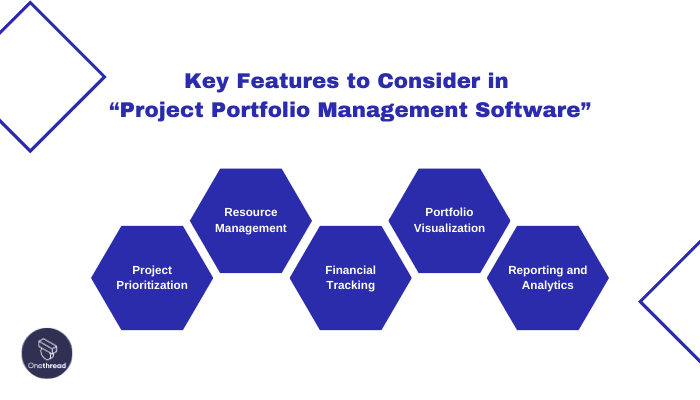
When evaluating Project Portfolio Management (PPM) Software for your organization, several key features should be considered to ensure it meets your specific needs. Here are essential features to keep in mind:
Project Prioritization
Effective project prioritization is crucial for aligning projects with strategic objectives and maximizing overall value. The software should allow you to define and weigh criteria such as strategic alignment, potential ROI, resource availability, and market demand. This enables you to rank and select projects that best contribute to the organization’s goals.
Resource Management
Efficiently managing resources across multiple projects ensures that teams are neither overallocated nor underutilized. The software should provide tools to allocate resources based on skills, availability, and project needs. This prevents resource bottlenecks and helps teams work on projects without overwhelming workloads.
Financial Tracking
Monitoring project budgets, expenses, and return on investment (ROI) is essential for financial accountability. The software should allow you to track expenses, compare them against the budget, and measure the ROI achieved from completed projects. This helps in ensuring projects are delivering value and staying within financial limits.
Portfolio Visualization
A clear and visually intuitive representation of the entire project portfolio provides a high-level overview of project status and progress. The software should offer customizable dashboards, charts, and graphs that display key performance indicators (KPIs) and allow stakeholders to quickly assess the health of the portfolio.
Reporting and Analytics
Robust reporting tools provide insights into project performance and portfolio health. The software should offer a variety of pre-built and customizable reports that showcase key metrics, project status, resource utilization, and financial data. Analytics features allow you to identify trends, patterns, and areas for improvement.
Top 5 Project Portfolio Management Software
Onethread

Onethread stands as an exceptional Project Portfolio Management (PPM) software, dedicated to enhancing project planning, execution, and collaboration. Its user-friendly interface and seamless navigation make it an indispensable tool for teams of all sizes.
With Onethread, you can create and manage an unlimited number of projects, ensuring adaptability for evolving teams. Its intuitive task tracking and assignment features simplify workflow management, while the calendar view empowers efficient scheduling and deadline adherence.
Onethread’s visual aids, such as the Kanban board and Gantt chart views, provide clear task management and project timeline tracking, ensuring projects stay on course. The dedicated Wiki section centralizes crucial project documentation, facilitating collaboration.
Integration with popular tools like Slack and Google Drive streamlines teamwork, and its mobile app enables on-the-go project management. With real-time updates, secure data storage, excellent customer support, and regular software updates, Onethread emerges as a comprehensive solution tailored to help teams achieve their project goals efficiently. In summary, Onethread is a top choice for those seeking a powerful PPM software solution.
Overview and key features
Task Tracking
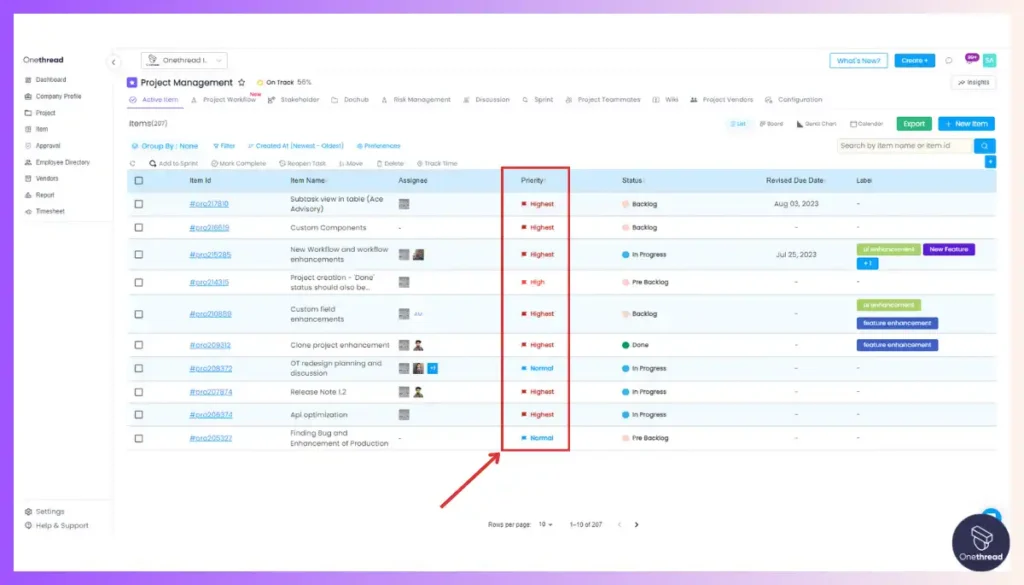
Managing tasks is made effortless with Onethread. You can assign, track, and prioritize tasks with ease. This ensures that every team member knows their responsibilities and can efficiently monitor task progress. This feature promotes transparency and accountability, crucial for project success.
Calendar View
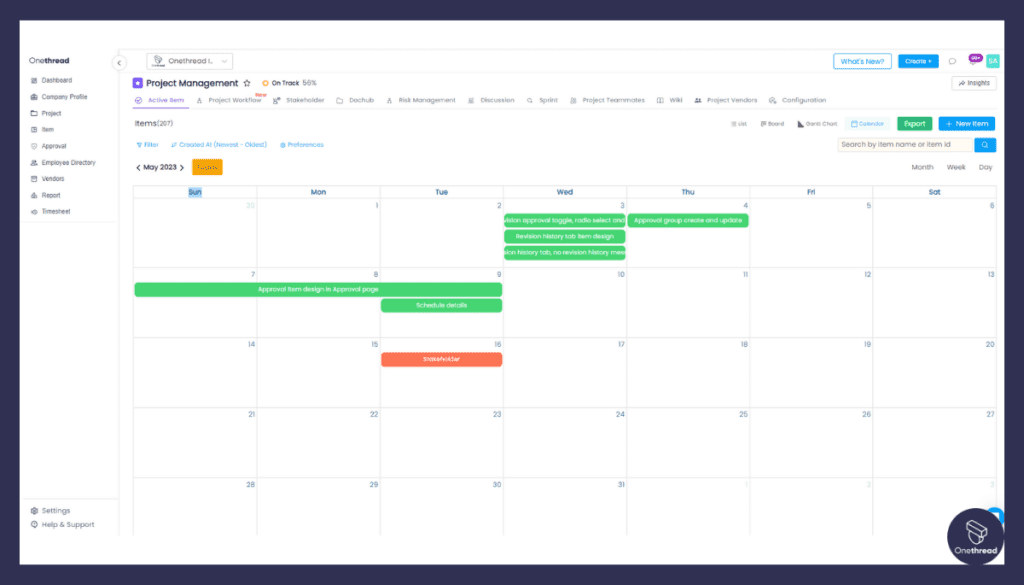
The calendar view is a powerful tool for project planning and deadline management. Visualizing project schedules and deadlines on a calendar provides an intuitive way to ensure tasks are completed on time. It’s particularly helpful for teams juggling multiple projects with overlapping timelines.
Kanban Board
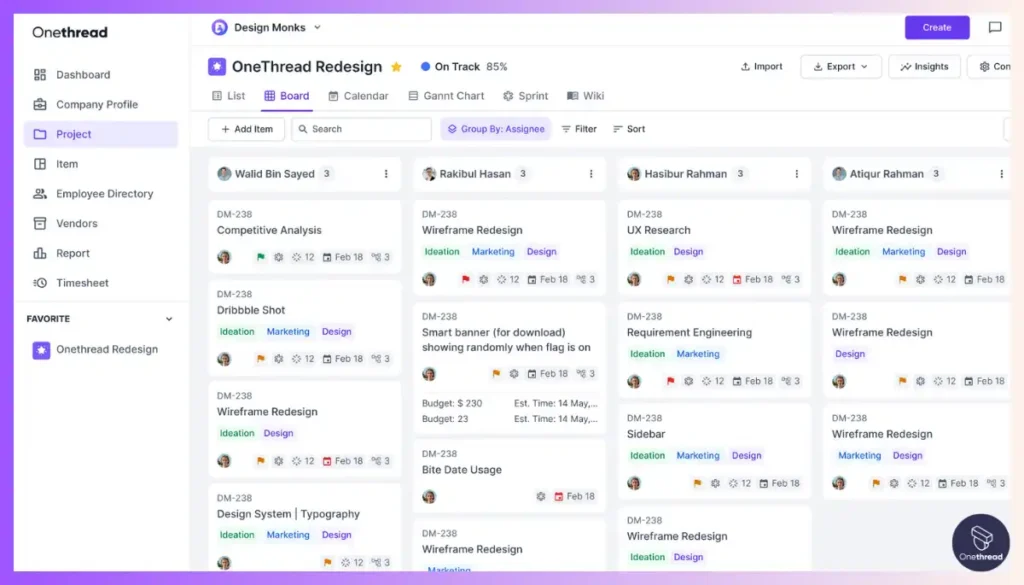
Onethread’s Kanban board is a visual treat for those who prefer an agile approach to task management. It allows you to organize tasks, track progress, and maintain a clear overview of your project’s status. The Kanban board encourages teams to work collaboratively and adapt swiftly to changing project needs.
Gantt Chart

Gantt charts offer a visual representation of project timelines, making them an essential feature for project planning and tracking. You can see how different tasks interconnect, ensuring projects stay on schedule. This visual clarity aids in making informed decisions regarding resource allocation and task prioritization.
Project Documentation (Wiki Section)
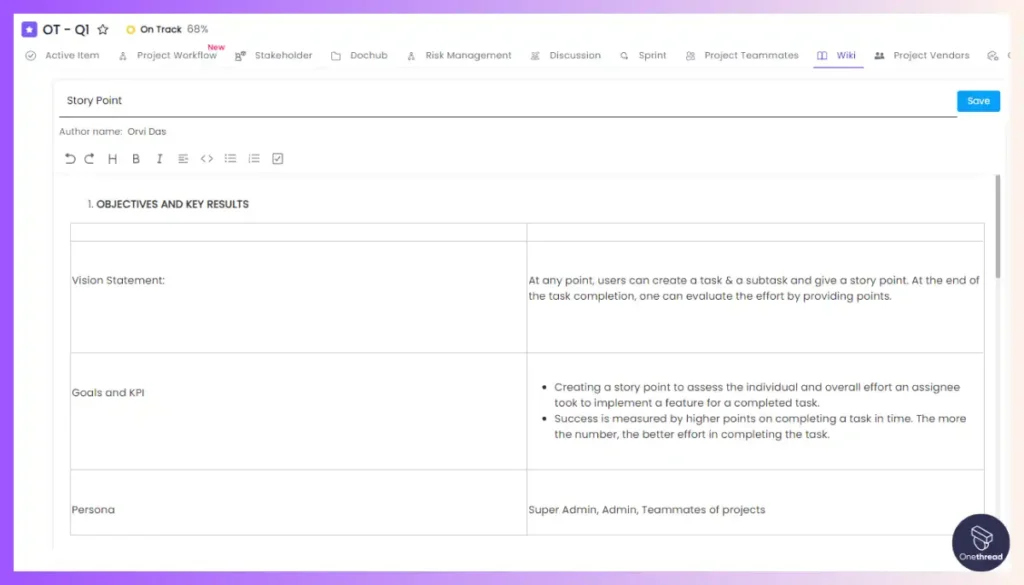
Centralizing project documentation in the Wiki section ensures that crucial information is easily accessible to all team members. No more hunting for documents or navigating through email threads. This feature enhances collaboration, reduces the risk of information silos, and streamlines knowledge sharing.
Vendor Collaboration
Collaborating with external partners is simplified through Onethread’s vendor feature. This is particularly beneficial when working with third-party contributors or contractors. Effective communication and project coordination become seamless, improving overall project efficiency.
Customizable Workflows
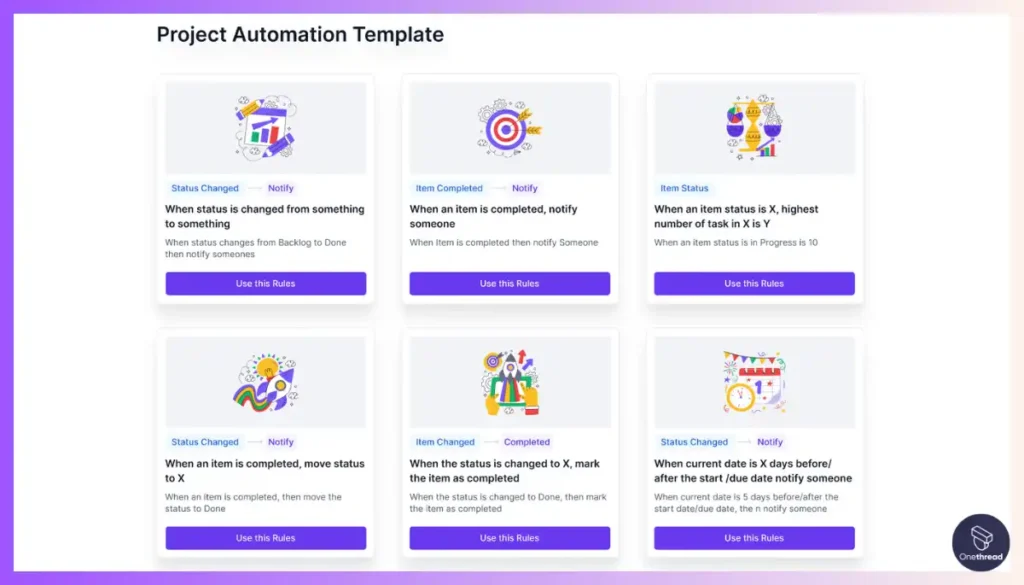
Onethread’s customizable workflows allow you to tailor the software to match your team’s unique processes. This feature ensures that the software adapts to your needs, enhancing team efficiency and ensuring that the tool aligns with your established workflows.
Pricing plans and options
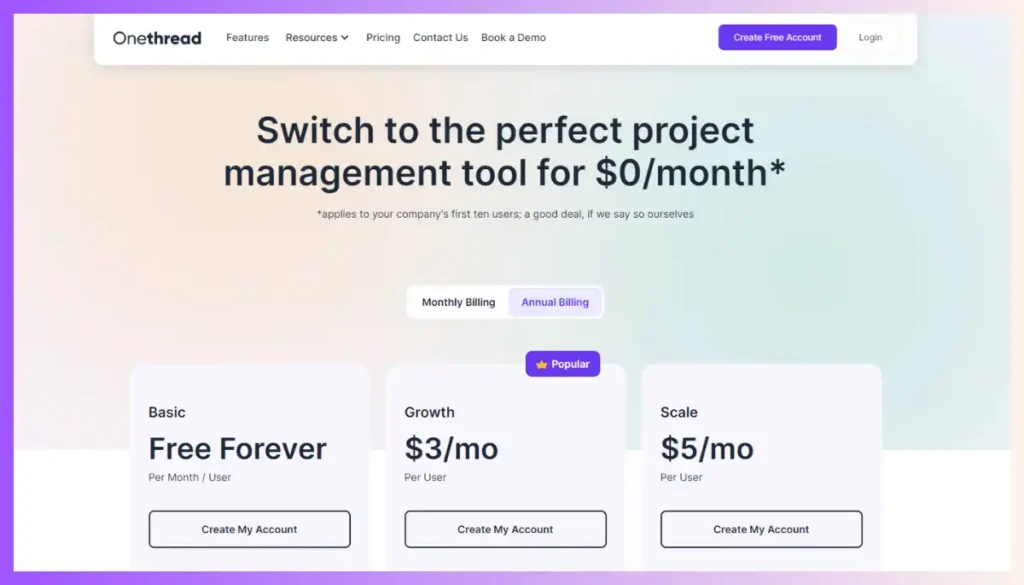
Onethread offers three pricing tiers:
- Free Plan: Provides basic project management, communication tools, and note-taking features.
- Growth Plan (Starting at $3.06 per user per month): Offers full project management and collaboration capabilities, advanced time tracking and reporting, and extensive customization options.
- Scale Plan (Starting at $6 per user per month): Includes advanced analytics and reporting, priority customer support, and enhanced security features.
Pros and cons of Onethread
Pros:
- User-friendly interface and intuitive navigation.
- Unlimited project management, accommodating team growth.
- Effective task tracking and assignment for transparent workflow management.
- Calendar view for visual project scheduling and deadline management.
- Seamless integration with popular tools like Slack and Google Drive.
Cons:
- Potential learning curve during initial use for some users.
Microsoft Project

Microsoft Project is a versatile project management software used by businesses worldwide to plan, execute, and track projects effectively. It’s the go-to choice for organizations deeply embedded in the Microsoft ecosystem.
This tool offers a plethora of benefits, including seamless integration with Microsoft Office Suite, ensuring efficient collaboration and data sharing across familiar applications. Users appreciate its robust project planning capabilities, encompassing Gantt charts, resource allocation, and timeline management.
The software’s comprehensive reporting features provide valuable insights into project progress, enabling informed decision-making. Microsoft Project is favored by enterprises for its scalability, making it suitable for both small teams and large organizations. It ensures projects align with strategic goals, ultimately enhancing productivity and delivering successful outcomes.
Product Details
Microsoft Project is a comprehensive project management software that aids in planning, scheduling, and tracking tasks and resources. It offers Gantt charts and various project views to visualize progress, manage timelines, and allocate resources efficiently.
- Platform: Available on Windows desktop and as a web-based version.
- Integrations: Seamlessly integrates with Microsoft Office Suite.
- UX: UX varies based on familiarity with Microsoft’s interface.
Company Valuation and Employee Numbers
Company Valuation: $2385 Billion.
Employees: 220,000+ employees
Founding Team
- Alan M. Boyd: Microsoft’s Manager of Product Development.
Driven by Alan M. Boyd’s leadership, the Microsoft Project emerged as a pioneering project management tool. Boyd’s vision and the team’s dedication resulted in software that simplified project planning and resource management, setting a standard for efficient project execution.
Key Features of Microsoft Project:
Gantt Charts
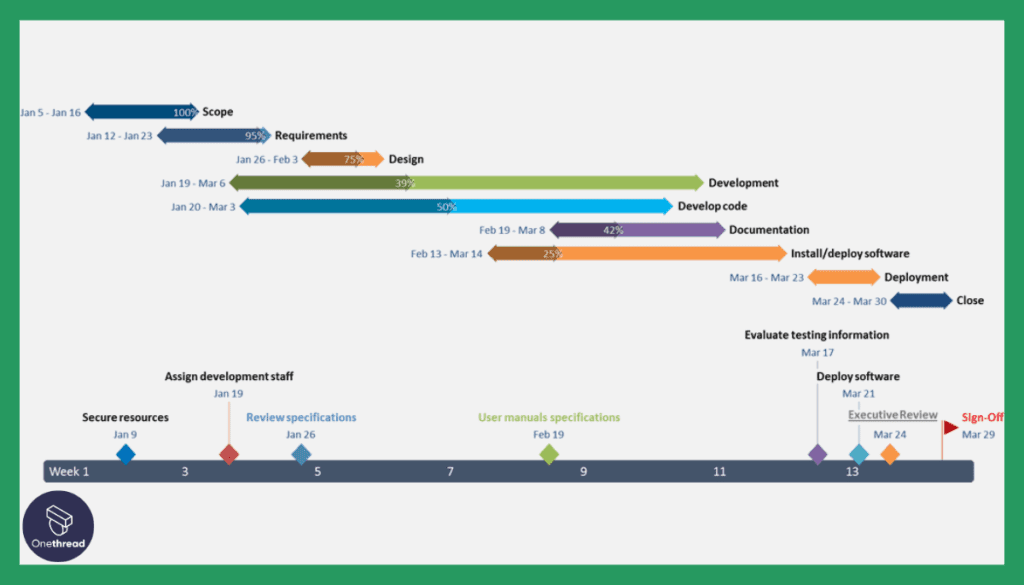
Microsoft Project’s prowess in creating and managing Gantt charts is a standout feature. Gantt charts offer a visual representation of project timelines, making it easy for project managers to plan tasks, allocate resources, and track progress. This visual tool is invaluable for ensuring that projects stay on schedule and that all team members are aware of their tasks and deadlines.
Resource Management
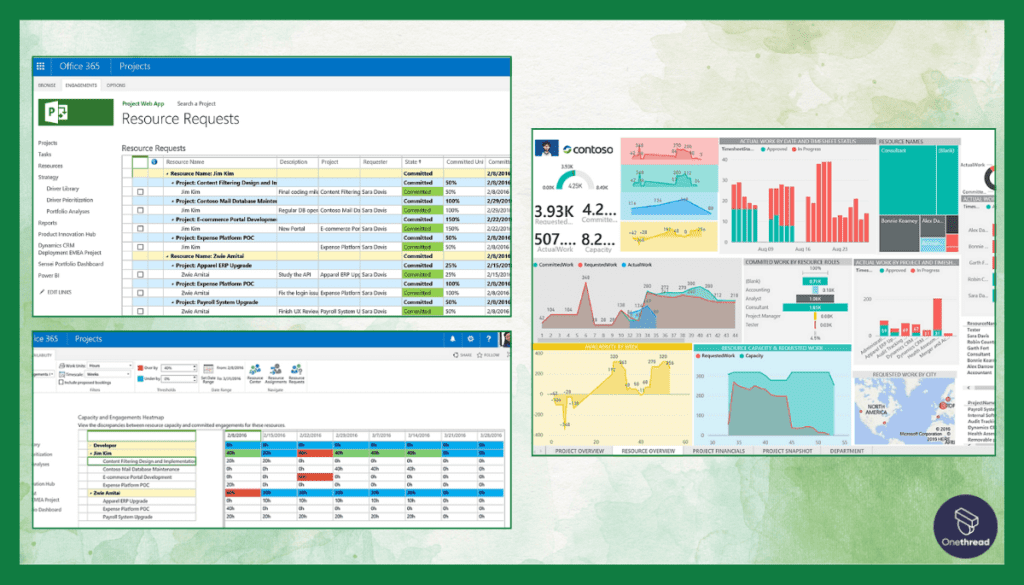
Microsoft Project provides robust resource allocation and management tools. This allows organizations to effectively assign and track resources, whether they are human resources, equipment, or materials. By optimizing resource allocation, project managers can ensure that projects are adequately staffed and that resources are used efficiently, ultimately contributing to project success.
Integration
The seamless integration with the Microsoft Office Suite is a major advantage. This integration facilitates efficient collaboration among team members by allowing them to work within familiar applications like Word, Excel, and Outlook. Data sharing and reporting become much easier, as project-related information can be easily transferred between these tools, enhancing overall productivity and communication.
Reporting and Analytics
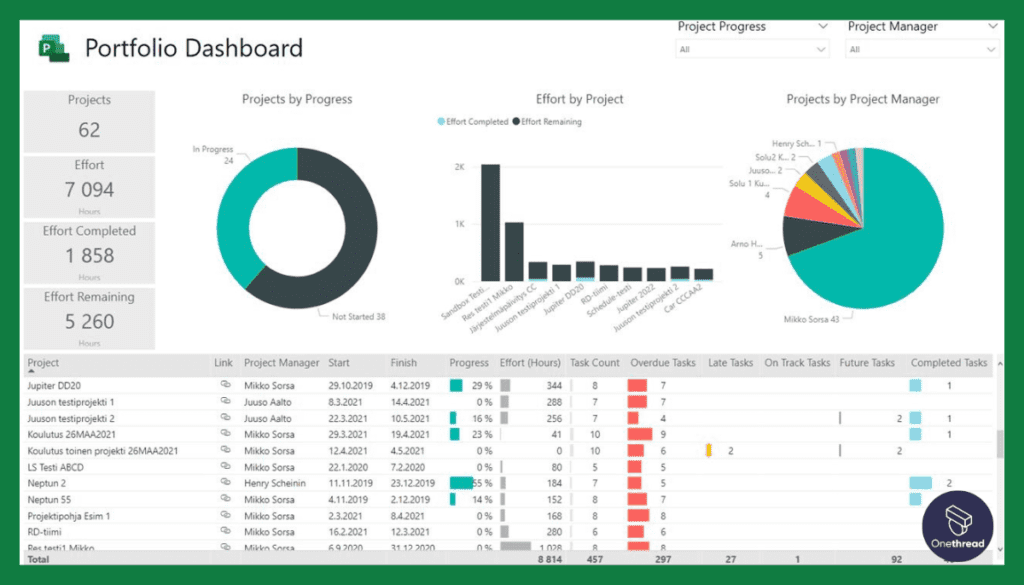
Microsoft Project offers comprehensive reporting and analytics features. These tools enable users to generate detailed reports on project progress, resource utilization, budgeting, and more. These insights are valuable for making informed decisions, identifying potential issues early, and ensuring that projects are on track to meet their goals.
Customization
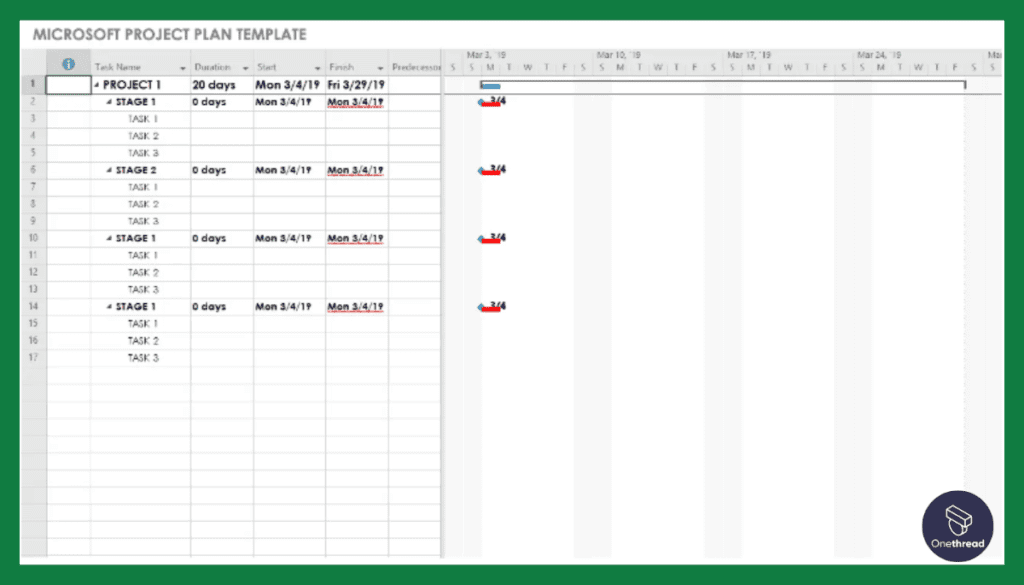
Another strength of Microsoft Project is its customization capabilities. Users can tailor the software to match their specific project processes and workflows. This flexibility ensures that the software adapts to the unique requirements of each project, enhancing its utility and relevance.
Pros and Cons
Pros:
- Robust Gantt chart capabilities for visual project planning.
- Seamless integration within the Microsoft ecosystem for efficient collaboration.
- Comprehensive resource management features.
- Scalable for both small teams and large enterprises.
Cons:
- The learning curve for new users is due to its feature-rich interface.
- Costly licensing for organizations with a limited budget.
Pricing and Plans

- Project Plan 1: $10/user/month
- Project Plan 3: $30/user/month
- Project Plan 5: $55/user/month
Customer Ratings
- G2: 4 (1,614+ reviews)
- Capterra: 4.4 (1,764+ reviews)
Our Review of the Microsoft Project
Microsoft Project is a feature-rich project management software that stands out for its exceptional project planning capabilities. Its Gantt chart functionality offers a detailed and visually appealing representation of project timelines, making it ideal for organizations with complex project structures. One of its major strengths is its seamless integration within the Microsoft ecosystem, ensuring that users can leverage tools like Word, Excel, and PowerPoint for enhanced collaboration and reporting.
Resource management in Microsoft Project is robust, allowing organizations to allocate and track resources effectively. This feature is particularly valuable for ensuring that projects are adequately staffed and that resources are used efficiently.
However, Microsoft Project can be challenging for new users due to its feature-rich interface, which may require some time for training and acclimatization. Additionally, the cost of licensing can be a significant factor for smaller organizations or startups.
Smartsheet
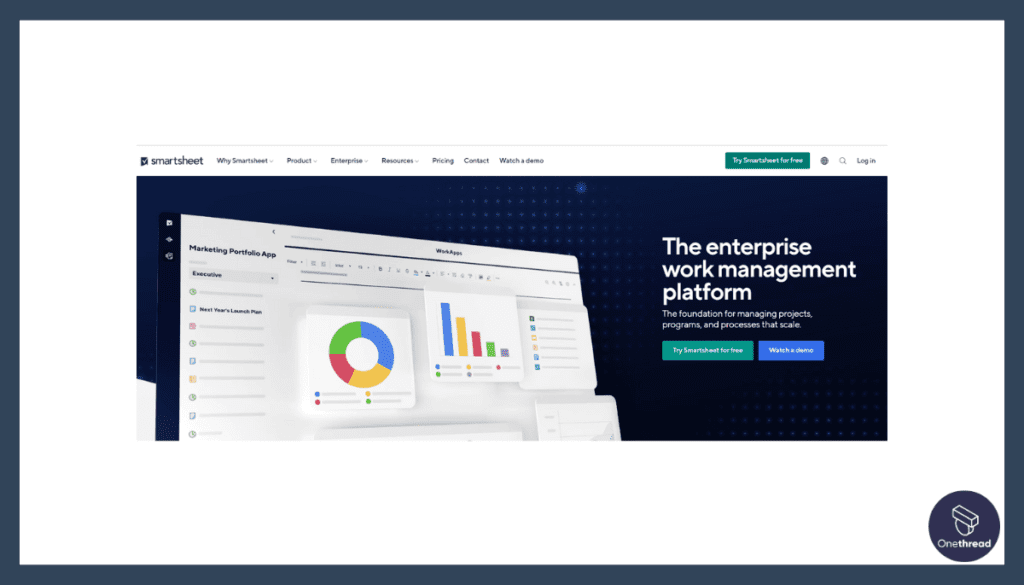
Smartsheet is a dynamic project management and collaboration tool that appeals to teams seeking flexibility and simplicity. It’s widely adopted for its user-friendly interface and spreadsheet-like layout, making it accessible to diverse teams.
Smartsheet offers benefits such as real-time collaboration, task management, and customizable workflows. Users appreciate its versatility, as it can serve as a project management platform or a team collaboration hub.
Smartsheet fosters efficient communication and transparency among team members, allowing them to work cohesively. It’s ideal for small to medium-sized teams looking for an intuitive solution to manage projects, tasks, and resources with ease.
Product Details
Smartsheet is a collaborative work management platform that combines spreadsheet-like functionality with project management features. It enables teams to organize tasks, create interactive timelines, and automate workflows, fostering collaboration and enhancing project visibility.
- Platform: Accessible via web browsers, iOS, and Android mobile apps.
- Integrations: Offers a wide range of integrations with tools like Microsoft Office, Google Workspace, and Salesforce.
- UX: Features an intuitive and user-friendly spreadsheet-like interface with consistent UX across devices.
Company Valuation and Employee Numbers
Company Valuation: $5.31B
Employees: 2600+ employees
Founding Team
- Mark Mader: President and CEO of Smartsheet, Leader of a prominent work management and automation platform
Mark Mader’s innovative approach united spreadsheets and project management, giving rise to Smartsheet. Mader’s leadership as CEO empowered teams with a versatile platform, combining flexibility and project tools to enhance collaboration and productivity.
Key Features of Smartsheet
Spreadsheet-Like Layout
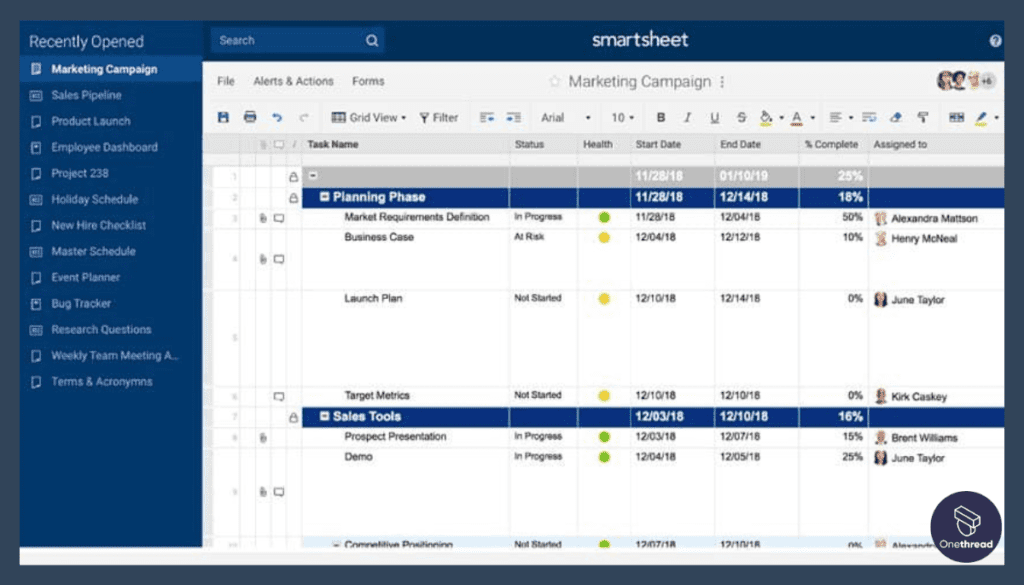
Smartsheet’s interface resembles a traditional spreadsheet, which makes it familiar and accessible to users who are accustomed to working with spreadsheet applications like Microsoft Excel. This layout simplifies the learning curve for new users and allows teams to quickly adapt to the platform.
Real-Time Collaboration
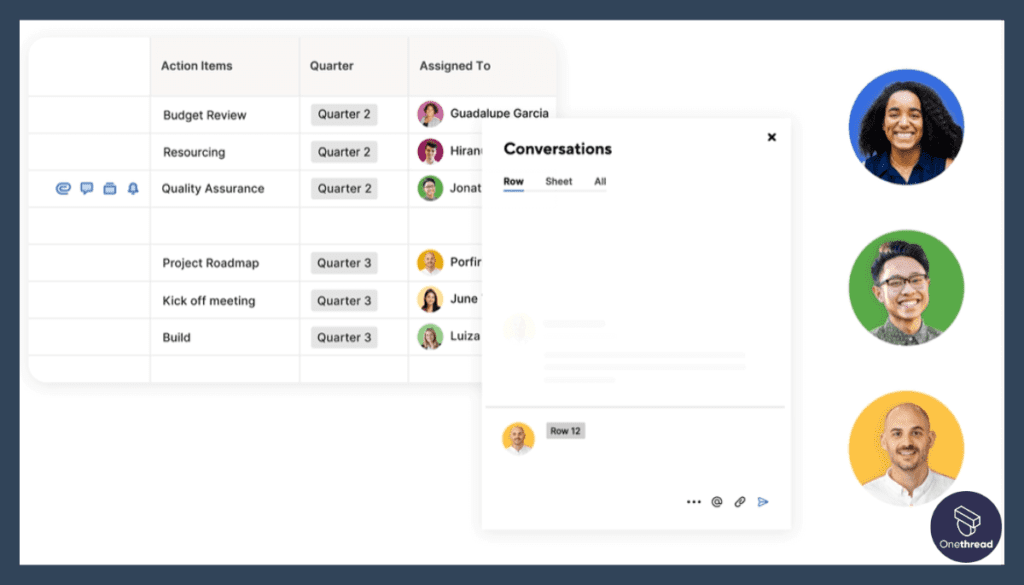
One of the standout features of Smartsheet is its real-time collaboration capabilities. Multiple team members can work on the same sheet simultaneously, eliminating the need for back-and-forth email exchanges and enabling more efficient communication. Users can see changes made by others in real-time, fostering better coordination and reducing the risk of duplication or conflicting efforts.
Task Management

Smartsheet’s task management tools enable teams to create, assign, and track tasks in a structured manner. This helps in clarifying responsibilities, setting priorities, and ensuring that projects progress smoothly. Task details such as due dates, owners, and status can be easily managed and updated within the platform.
Customizable Workflows
Every team has its unique processes and workflows. Smartsheet recognizes this and allows users to customize the platform to align with their specific requirements. Whether it’s a simple task list or a complex project with multiple stages, teams can configure Smartsheet to match their workflow and project management preferences.
Versatility
Smartsheet is not limited to being just a project management tool. It can also serve as a centralized collaboration hub for teams, enabling them to track projects, share documents, manage calendars, and handle other collaborative tasks. Its adaptability makes it suitable for various types of projects and team sizes.
Pros and Cons
Pros:
- User-friendly interface and spreadsheet-like layout.
- Real-time collaboration, reducing the need for extensive email communication.
- Versatile, serving as a project management platform or team collaboration hub.
- Task management and prioritization for workflow clarity.
Cons:
- Limited advanced project management features compared to specialized tools.
- Potential complexity in setting up complex workflows.
Pricing and Plans
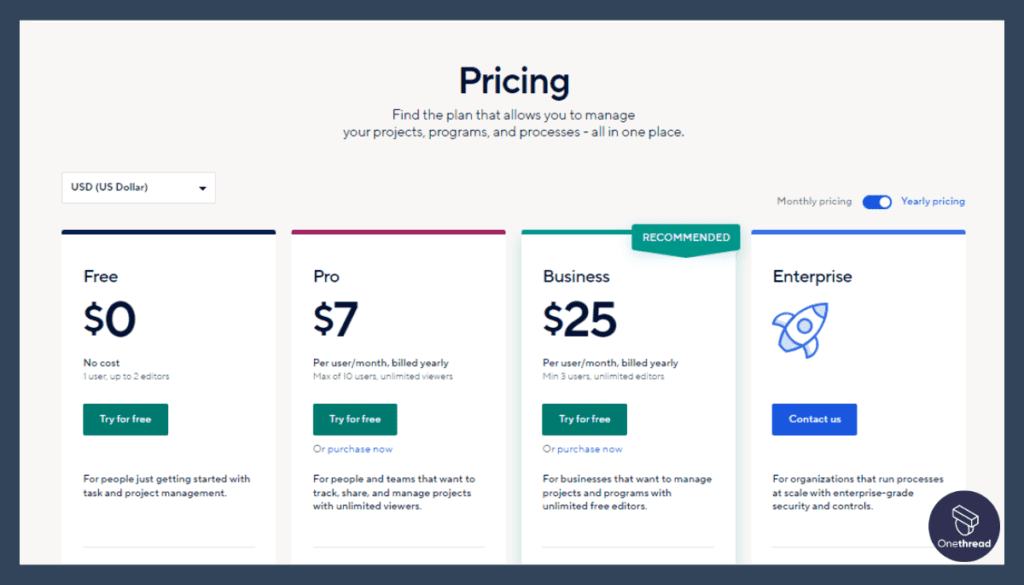
- Individual: $14/user/month, unlimited projects
- Business: $25/user/month, unlimited projects with all advanced features
- Enterprise: Custom pricing
Customer Ratings
- G2: 4.4 (13,923+ reviews)
- Capterra: 4.5 (2,959+ reviews)
Our Review of Smartsheet
Smartsheet continues to impress with its remarkable blend of simplicity and functionality. Its standout feature is undoubtedly its user-friendly interface, which closely resembles a spreadsheet, making it a familiar and inviting platform for users of all backgrounds.
This accessibility extends a warm welcome even to those who may not possess extensive project management experience, ensuring that teams can quickly onboard and begin managing tasks and projects efficiently.
One of Smartsheet’s crowning achievements is its emphasis on real-time collaboration. This feature significantly reduces the need for lengthy email exchanges and cumbersome communication processes. Instead, teams can seamlessly collaborate within the platform, leading to enhanced teamwork and transparency. This is particularly valuable in today’s fast-paced business environment, where timely and effective communication is key to project success.
While Smartsheet may not boast the advanced project management features found in specialized tools, it more than compensates with its robust task management and customization capabilities. Teams can mold the software to fit their specific workflows and processes, ensuring that it aligns precisely with their unique needs and project requirements.
This adaptability sets Smartsheet apart as an ideal solution for teams seeking a tool that can evolve with them as they grow and tackle increasingly complex projects.
Asana
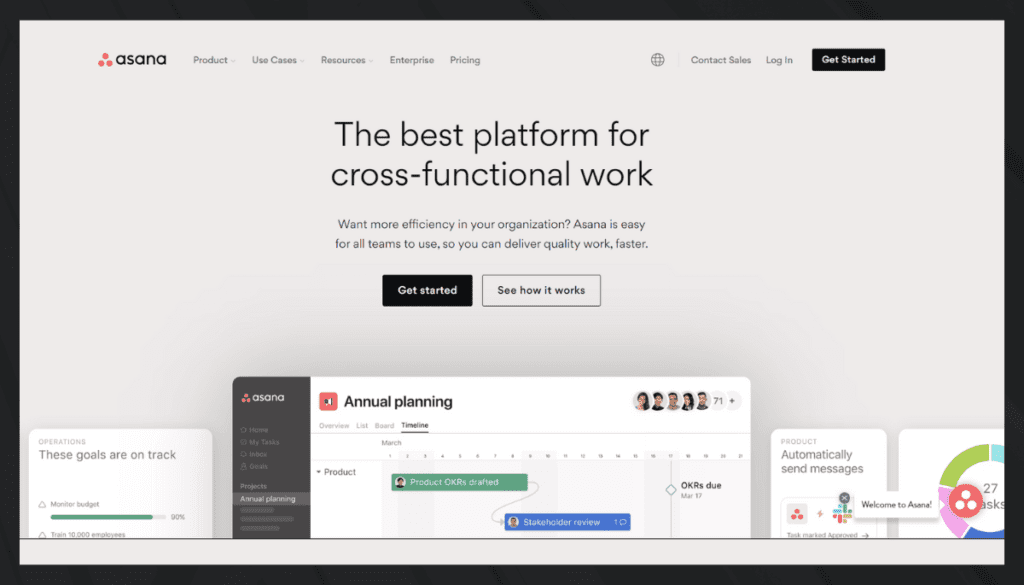
Asana is a popular task and project management tool known for its simplicity and real-time collaboration features. People use Asana to streamline project management, enhance team productivity, and promote clarity in their workflows.
The tool’s benefits include task assignment, prioritization, and deadline tracking. It offers a user-friendly interface that encourages teams to work efficiently and stay aligned with their objectives.
Asana stands out for its emphasis on real-time collaboration, enabling teams to work seamlessly together and reducing the need for extensive email communication. It’s an excellent choice for those seeking a straightforward, task-focused solution for project management.
Product Details
Asana is a versatile task and project management tool that facilitates team coordination through task assignments, progress tracking, and communication. Its intuitive interface and customizable workflows help teams streamline their work and achieve project goals effectively.
- Platform: Accessible through web browsers, iOS, and Android mobile apps.
- Integrations: Integrates with popular third-party applications such as Slack and Dropbox.
- UX: Boasts a user-friendly and straightforward UX designed for teams of all backgrounds with a clear and intuitive layout for task and project management.
Company Valuation and Employee Numbers
Company Valuation: $334.9M
Employees: 2593+ (2023)
Founding Team
- Dustin Moskovitz: Co-founder of Asaan, Co-founder of Facebook, contributing to its early development
- Justin Rosenstein: CEO of Asana, Instrumental in creating a popular project management and collaboration tool
Dustin Moskovitz’s post-Facebook venture led to Asana’s creation, redefining task management. His insight into seamless teamwork birthed a platform that streamlined tasks, communication, and accountability, fostering a culture of efficient collaboration.
Key Features of Asana
Task Assignment
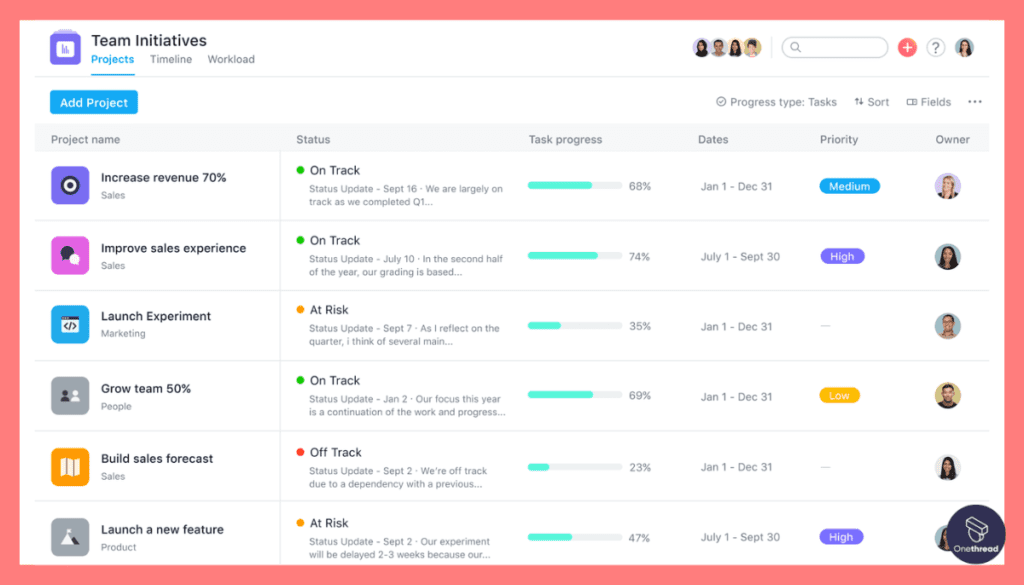
Asana makes it easy to assign tasks to specific team members, ensuring that each task has a clear owner and is associated with a responsible individual. This not only establishes accountability but also reduces confusion about who is responsible for each task’s completion.
Simplicity
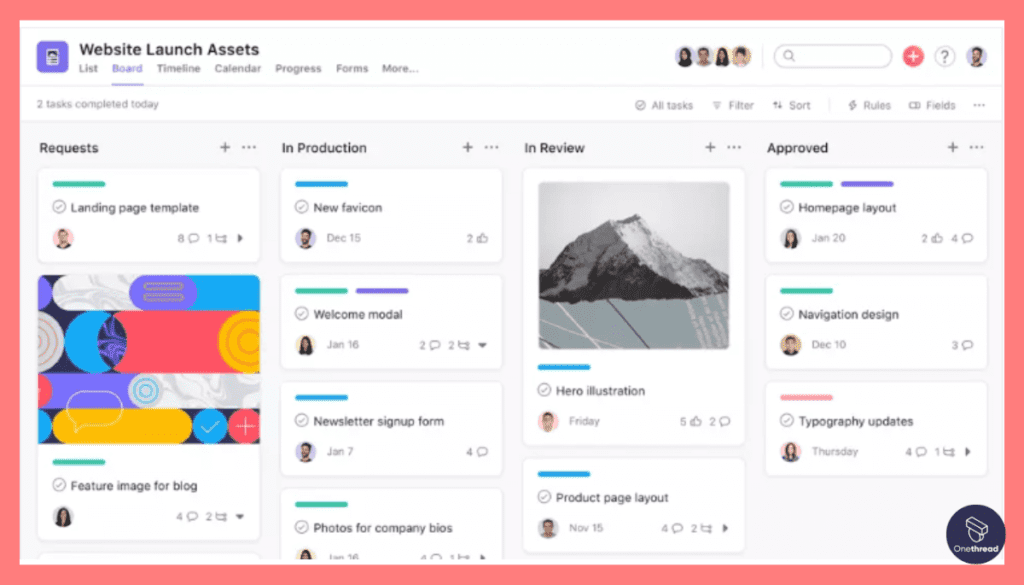
Asana’s user-friendly interface is designed for simplicity and ease of use. Its intuitive layout and straightforward features make it accessible to teams of all sizes, including those who might not have extensive experience with project management software. This simplicity encourages faster adoption and reduces the learning curve.
Real-Time Collaboration
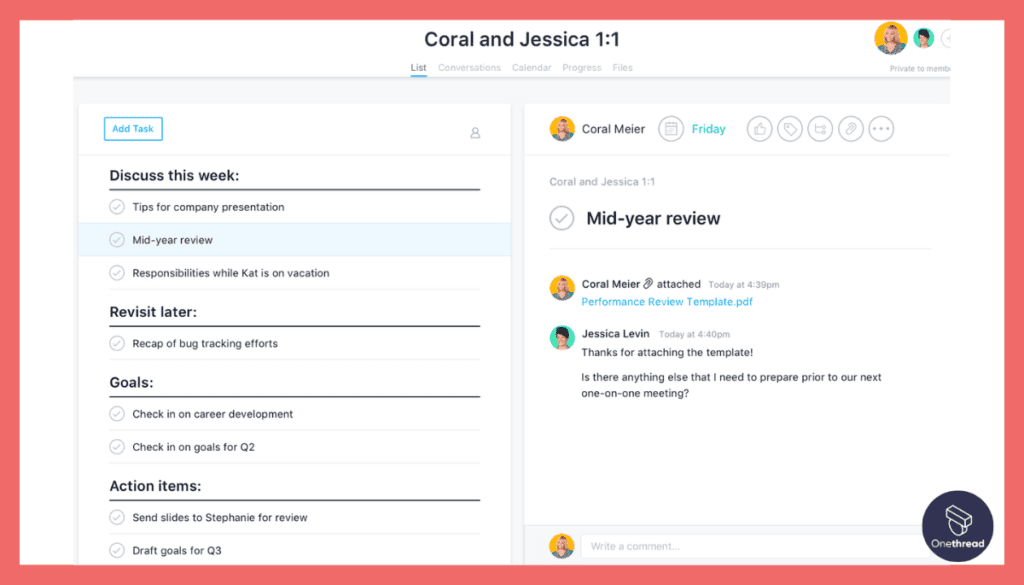
Collaboration is at the core of Asana’s design. Teams can collaborate on tasks, projects, and shared goals in real-time. This feature minimizes delays caused by waiting for updates, feedback, or approvals, leading to smoother workflows and faster project progress.
Task Prioritization
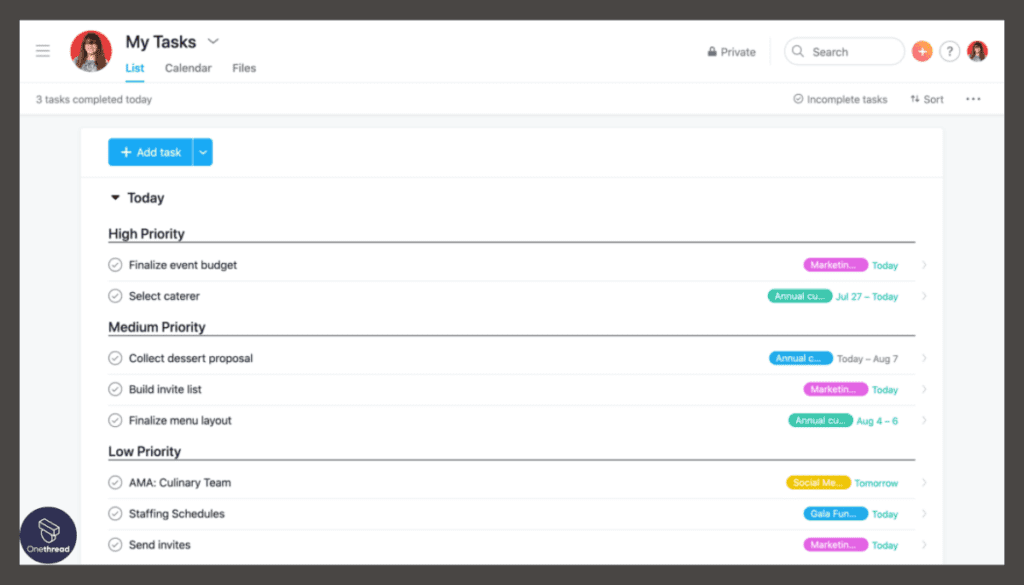
With Asana, users can prioritize tasks by assigning due dates, setting deadlines, and indicating task importance. This helps team members focus on tasks that are most critical and time-sensitive, improving overall productivity and ensuring that nothing falls through the cracks.
Task Tracking
Asana’s task-tracking feature allows team members to monitor the progress of tasks and projects. It provides visibility into task status, completion percentages, and any obstacles faced. This transparency helps in identifying potential bottlenecks and taking corrective actions in a timely manner.
Customization
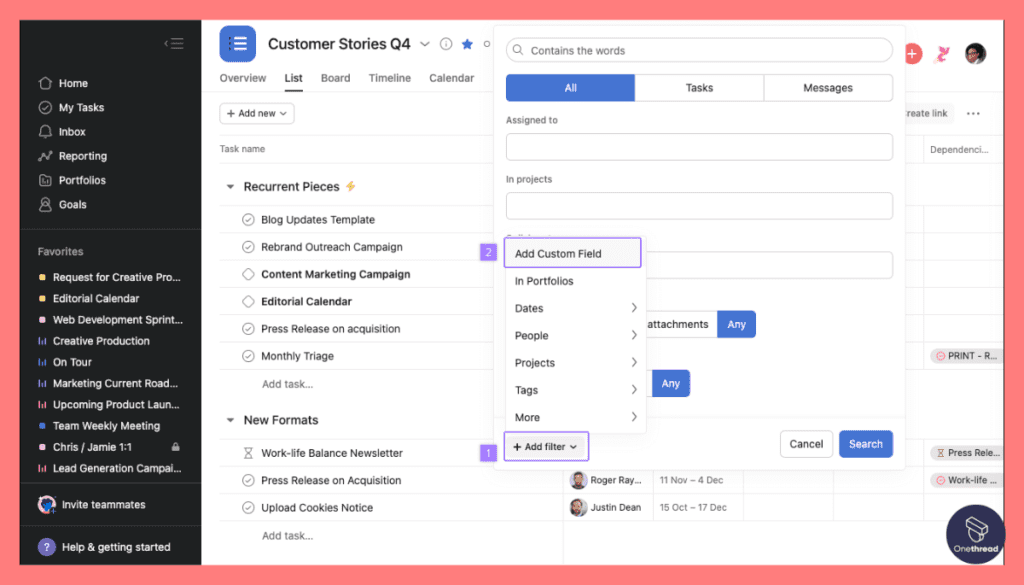
Every team has its unique processes and workflows. Asana recognizes this and allows users to customize their workspaces and task boards to match their specific needs. This flexibility ensures that the platform adapts to the way each team operates, promoting efficient collaboration.
Pros and Cons
Pros:
- Simplified task assignment and tracking for streamlined project management.
- Real-time collaboration to enhance team efficiency.
- A User-friendly interface is suitable for diverse teams.
- Task prioritization for improved productivity.
Cons:
- May lack advanced project management features required by larger organizations.
- Integration capabilities may not be as extensive as other tools.
Pricing and Plans
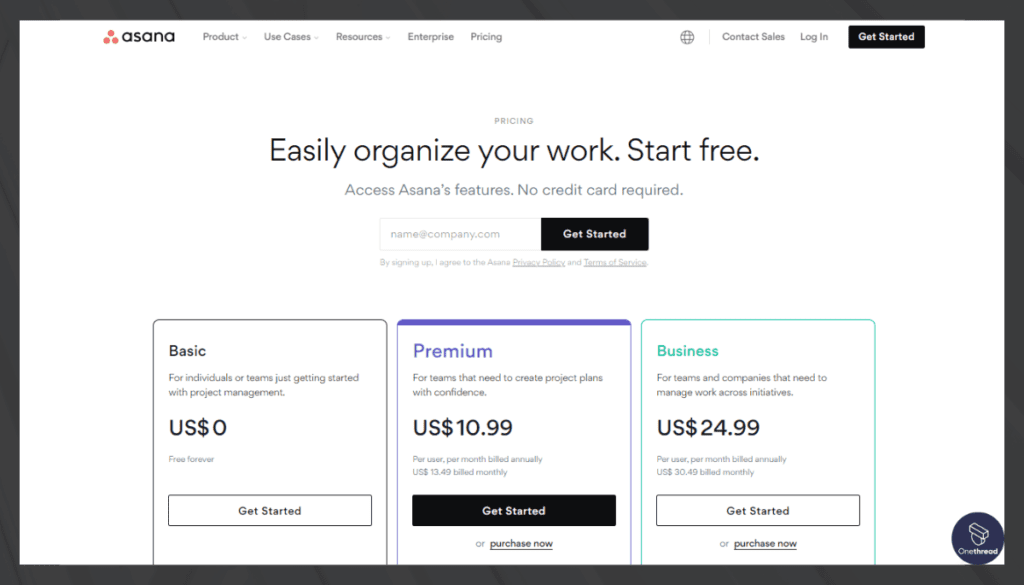
Asana offers a range of pricing tiers designed to cater to different requirements:
- Free Plan: This tier provides essential features suitable for individuals and small teams.
- Premium Plan: For $10.99 per user per month, you can access enhanced customization and advanced capabilities.
- Business Plan: Priced at $24.99 per user per month, this tier is crafted for complex projects and includes additional tools.
- Enterprise Plan: Custom pricing options are available, offering specialized support and enhanced security features.
Customer Ratings
- G2: 4.3 (9,446+ reviews)
- Capterra: 4.5 (22,681 reviews)
Our Review of Asana
Asana is a shining example of how simplicity can be a powerful asset in the world of project management. It excels in providing teams with an easily navigable and straightforward interface, ensuring that both novices and experienced users can swiftly adapt to its features. This user-friendliness fosters a sense of inclusivity, allowing teams to quickly get up to speed and begin efficiently managing tasks and projects.
Real-time collaboration is one of Asana’s standout strengths. It serves as a catalyst for reducing communication bottlenecks within teams. Instead of relying on lengthy email threads or multiple messaging apps, team members can work seamlessly within the platform. This not only enhances the efficiency of teamwork but also encourages a culture of transparency and accountability.
However, it’s important to note that Asana’s focus on simplicity, while a boon for many, may not fully cater to the complex needs of larger organizations. Some advanced project management features found in specialized tools might be lacking, which could be a limitation for enterprises with intricate project structures and requirements.
Planview
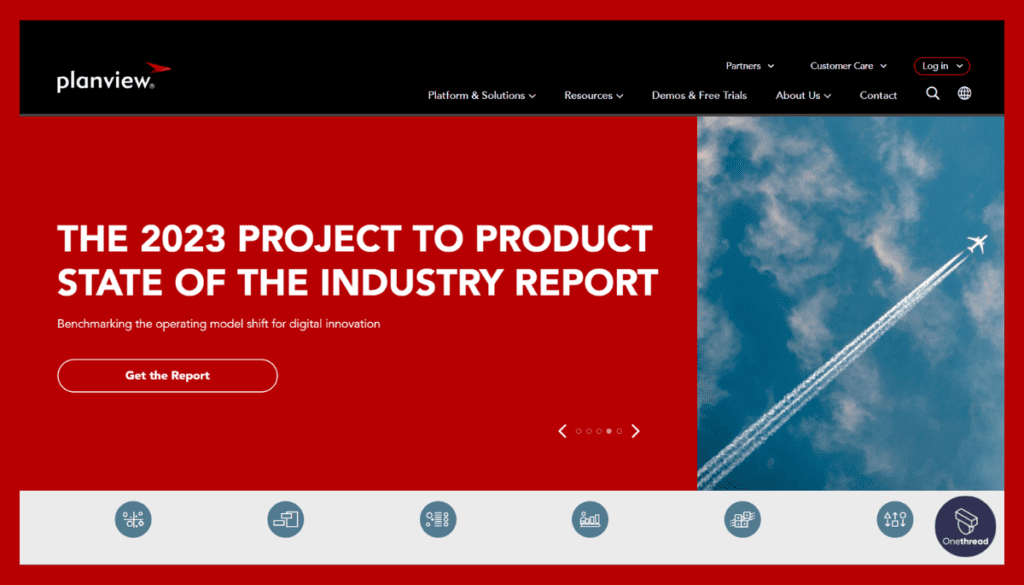
Planview is a robust Project Portfolio Management (PPM) solution tailored for organizations with complex project portfolios. People turn to Planview to align projects with strategic goals, optimize resource allocation, and manage financial aspects effectively.
Its benefits include project prioritization, financial tracking, resource management, and comprehensive reporting and analytics. Planview ensures that enterprises can make informed decisions regarding project investments and resource allocation.
Its scalability makes it suitable for large organizations looking for deep PPM capabilities to manage diverse projects efficiently. Planview enhances visibility, fosters collaboration, and empowers organizations to achieve project excellence while aligning with overarching business strategies.
Product Details
Planview is a robust enterprise-level portfolio and resource management solution that assists organizations in optimizing resource allocation, aligning projects with strategic goals, and maintaining a holistic view of their project portfolios. It supports decision-making by providing real-time insights into project performance and resource utilization.
- Platform: Typically deployed as a web-based application for multi-platform accessibility.
- Integrations: Offers integrations with various tools and services, including Microsoft Office, Jira, and Salesforce.
- UX: UX may vary depending on the module and configuration used. It may have a learning curve in complex enterprise deployments but is designed to facilitate efficient project portfolio management once users become familiar with it.
Company Valuation and Employee Numbers
Company Valuation: $1.6B
Employees: 1000+ employees
Founding Team
- Patrick Durbin: Founder of Planview, Contributor to enterprise portfolio management and work management solutions
- Razat Gaurav: Chief executive officer of Planview, a Leading provider of strategic portfolio and work management solutions
Patrick Durbin’s pioneering spirit founded Planview to tackle complex portfolio challenges. Durbin’s vision laid the groundwork for software that revolutionized portfolio management, enabling organizations to optimize resources and strategic alignment. Under Razat Gaurav’s guidance, Planview’s impact continues to grow, reshaping enterprise work management.
Key Features of Planview
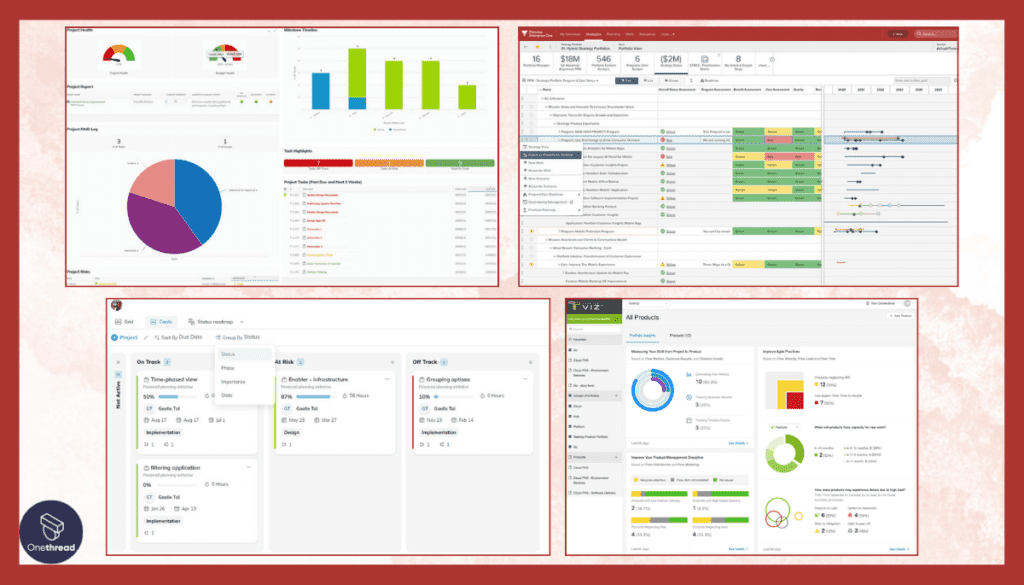
Comprehensive PPM Features
Planview offers a robust set of PPM features, including project prioritization, financial tracking, and resource management. These features allow organizations to evaluate and select the most impactful projects, track their financial performance, and manage resources efficiently across the entire portfolio.
Strategic Alignment
One of the core strengths of Planview is its ability to help organizations align their projects with strategic goals. By providing visibility into how individual projects contribute to overarching business objectives, Planview ensures that project portfolios are focused on delivering value and driving the organization’s success.
Resource Optimization
Efficient resource allocation and management are critical for successful project execution. Planview facilitates resource optimization by providing tools to allocate resources effectively across multiple projects, avoiding overallocation and ensuring that the right resources are available for each task.
Reporting and Analytics
Planview’s reporting and analytics capabilities offer insights into project performance and portfolio health. Organizations can generate various reports, dashboards, and visualizations to monitor key metrics, track progress, and identify areas for improvement. This data-driven approach enables informed decision-making and helps in adapting strategies as needed.
Customization
Planview allows organizations to tailor workflows, task statuses, and processes to their specific needs. This customization ensures that the tool aligns seamlessly with existing processes and supports the unique requirements of the organization. This flexibility promotes smoother adoption and integration into the organization’s workflow.
Integration
Planview’s integration capabilities are crucial for creating a holistic view of business operations. It can seamlessly integrate with various tools and systems that are already in use within the organization, such as project management software, CRM systems, and collaboration tools. This integration enhances data sharing, improves collaboration, and supports a more unified approach to managing projects and resources.
Pros and Cons
Pros:
- Comprehensive Project Portfolio Management (PPM) features.
- Strategic alignment of projects with business goals.
- Resource optimization and efficient allocation.
- Robust reporting and analytics capabilities.
Cons:
- May be overly complex and costly for smaller organizations.
- Implementation and learning curve for full utilization can be substantial.
Pricing and Plans
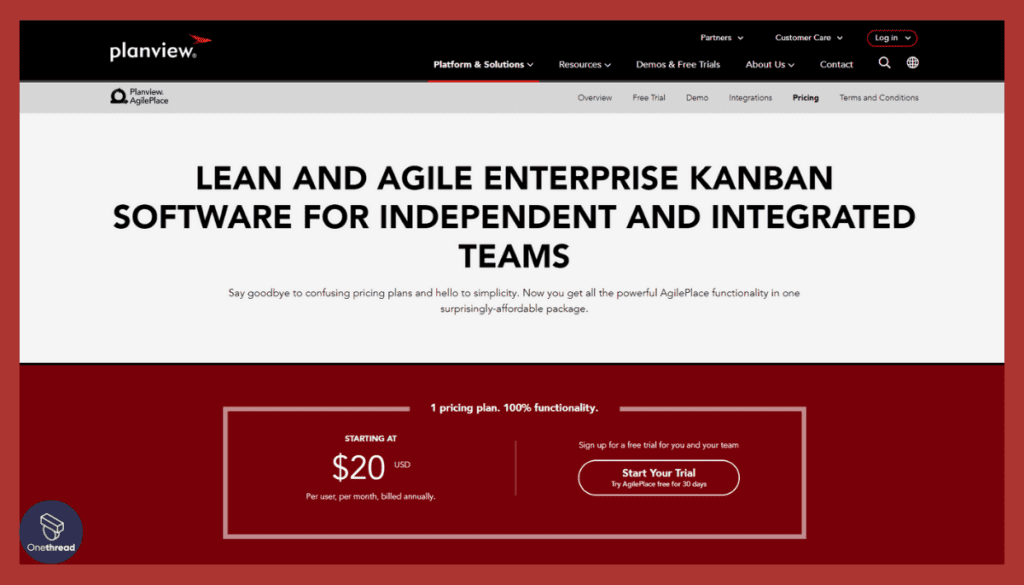
- Free
- Starting: $20 USD Per user, per month, billed annually.
Customer Ratings
- G2: 4.1 (530+ reviews)
- Capterra: 3.9 (13 reviews)
Our Review of Planview
Planview stands tall as a comprehensive and powerful Project Portfolio Management (PPM) solution, catering specifically to organizations with intricate and multifaceted project portfolios. Its most noteworthy feature is its remarkable ability to align projects seamlessly with strategic business goals, ensuring that every initiative contributes directly to the overarching objectives of the enterprise.
One of Planview’s standout strengths is its robust resource optimization capabilities. For organizations with a myriad of projects and limited resources, this feature becomes a critical asset.
It enables efficient allocation and management of resources, ensuring that projects are adequately staffed and that resources are utilized optimally. This not only improves project success rates but also enhances overall resource efficiency.
Financial tracking is another area where Planview shines. It provides organizations with a comprehensive view of project financials, helping them monitor budgets, costs, and expenditures meticulously. This level of financial control is invaluable for enterprises, especially those managing numerous projects with varying financial implications.
However, it’s crucial to acknowledge that Planview’s strengths are accompanied by certain challenges. The platform’s complexity and cost may be daunting for smaller organizations or startups, which may find it more suitable to opt for simpler and more budget-friendly project management solutions. The implementation of Planview and achieving full utilization can require a substantial learning curve, particularly for those unfamiliar with PPM practices.
Getting the Most Out of Project Portfolio Management Software
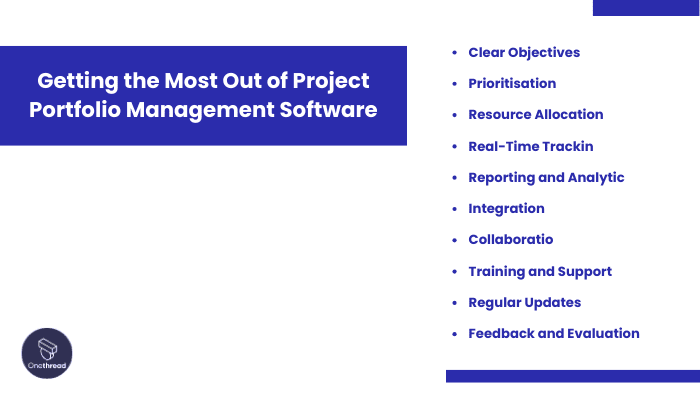
Unlock the full potential of your Project Portfolio Management Software with these essential principles:
- Clear Objectives: Define your project goals and align them with your organization’s strategic objectives.
- Prioritization: Use the software to prioritize projects based on their importance and impact.
- Resource Allocation: Efficiently allocate resources to ensure projects are adequately staffed.
- Real-Time Tracking: Continuously monitor project progress and make adjustments as needed.
- Reporting and Analytics: Leverage the software’s reporting and analytics features for data-driven decision-making.
- Integration: Integrate the software with other tools and systems for seamless data sharing.
- Collaboration: Foster collaboration among teams and stakeholders using the software’s collaborative features.
- Training and Support: Ensure that your team is well-trained and has access to support resources.
- Regular Updates: Stay updated with software enhancements and new features for improved efficiency.
- Feedback and Evaluation: Gather feedback and evaluate the software’s performance to make necessary improvements.
Conclusion
As we conclude our journey through the realm of Project Portfolio Management Software, it’s clear that these tools offer a diverse array of capabilities. Whether you’re a small team or a large enterprise, there’s a solution tailored to your needs.
Embrace the power of data-driven decision-making, streamlined collaboration, and efficient resource allocation. With the best project portfolio management software, your projects can soar to new heights, driving success and growth for your organization.
Frequently Asked Questions (FAQs)
How does PPM software differ from standard project management software?
- PPM software focuses on managing a portfolio of projects, aligning them with an organization’s strategic goals. It often includes features like project prioritization, resource allocation, and financial tracking, while standard project management software typically concentrates on individual project execution.
What is the typical pricing model for PPM software, and how can I choose the right one for my budget?
- PPM software pricing models can vary, including per-user, per-project, or enterprise-level licensing. To choose the right one for your budget, consider the size of your organization, the number of users, and the specific features you need.
Can PPM software integrate with other tools and systems used by my organization?
- Yes, most PPM software solutions offer integration capabilities with popular tools like Microsoft Office, collaboration platforms like Slack, and CRM systems.
How can PPM software help with strategic decision-making?
- PPM software provides data-driven insights through reporting and analytics. It offers visibility into project progress, resource utilization, and financial aspects.
What are some best practices for successful PPM software implementation and adoption?
- Successful implementation involves clear communication, proper training, and the involvement of key stakeholders. Start with a well-defined plan, gradually introduce the software, and provide ongoing support.
